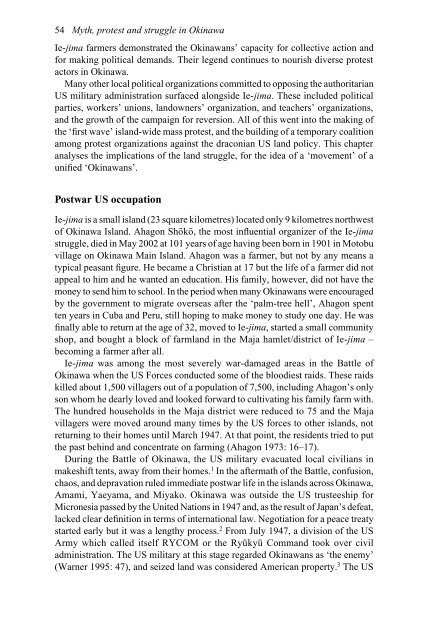Myth, Protest and Struggle in Okinawa
Myth, Protest and Struggle in Okinawa
Myth, Protest and Struggle in Okinawa
You also want an ePaper? Increase the reach of your titles
YUMPU automatically turns print PDFs into web optimized ePapers that Google loves.
54 <strong>Myth</strong>, protest <strong>and</strong> struggle <strong>in</strong> Ok<strong>in</strong>awa<br />
Ie-jima farmers demonstrated the Ok<strong>in</strong>awans’ capacity for collective action <strong>and</strong><br />
for mak<strong>in</strong>g political dem<strong>and</strong>s. Their legend cont<strong>in</strong>ues to nourish diverse protest<br />
actors <strong>in</strong> Ok<strong>in</strong>awa.<br />
Many other local political organizations committed to oppos<strong>in</strong>g the authoritarian<br />
US military adm<strong>in</strong>istration surfaced alongside Ie-jima. These <strong>in</strong>cluded political<br />
parties, workers’ unions, l<strong>and</strong>owners’ organization, <strong>and</strong> teachers’ organizations,<br />
<strong>and</strong> the growth of the campaign for reversion. All of this went <strong>in</strong>to the mak<strong>in</strong>g of<br />
the ‘first wave’ isl<strong>and</strong>-wide mass protest, <strong>and</strong> the build<strong>in</strong>g of a temporary coalition<br />
among protest organizations aga<strong>in</strong>st the draconian US l<strong>and</strong> policy. This chapter<br />
analyses the implications of the l<strong>and</strong> struggle, for the idea of a ‘movement’ of a<br />
unified ‘Ok<strong>in</strong>awans’.<br />
Postwar US occupation<br />
Ie-jima is a small isl<strong>and</strong> (23 square kilometres) located only 9 kilometres northwest<br />
of Ok<strong>in</strong>awa Isl<strong>and</strong>. Ahagon Shōkō, the most <strong>in</strong>fluential organizer of the Ie-jima<br />
struggle, died <strong>in</strong> May 2002 at 101 years of age hav<strong>in</strong>g been born <strong>in</strong> 1901 <strong>in</strong> Motobu<br />
village on Ok<strong>in</strong>awa Ma<strong>in</strong> Isl<strong>and</strong>. Ahagon was a farmer, but not by any means a<br />
typical peasant figure. He became a Christian at 17 but the life of a farmer did not<br />
appeal to him <strong>and</strong> he wanted an education. His family, however, did not have the<br />
money to send him to school. In the period when many Ok<strong>in</strong>awans were encouraged<br />
by the government to migrate overseas after the ‘palm-tree hell’, Ahagon spent<br />
ten years <strong>in</strong> Cuba <strong>and</strong> Peru, still hop<strong>in</strong>g to make money to study one day. He was<br />
f<strong>in</strong>ally able to return at the age of 32, moved to Ie-jima, started a small community<br />
shop, <strong>and</strong> bought a block of farml<strong>and</strong> <strong>in</strong> the Maja hamlet/district of Ie-jima –<br />
becom<strong>in</strong>g a farmer after all.<br />
Ie-jima was among the most severely war-damaged areas <strong>in</strong> the Battle of<br />
Ok<strong>in</strong>awa when the US Forces conducted some of the bloodiest raids. These raids<br />
killed about 1,500 villagers out of a population of 7,500, <strong>in</strong>clud<strong>in</strong>g Ahagon’s only<br />
son whom he dearly loved <strong>and</strong> looked forward to cultivat<strong>in</strong>g his family farm with.<br />
The hundred households <strong>in</strong> the Maja district were reduced to 75 <strong>and</strong> the Maja<br />
villagers were moved around many times by the US forces to other isl<strong>and</strong>s, not<br />
return<strong>in</strong>g to their homes until March 1947. At that po<strong>in</strong>t, the residents tried to put<br />
the past beh<strong>in</strong>d <strong>and</strong> concentrate on farm<strong>in</strong>g (Ahagon 1973: 16–17).<br />
Dur<strong>in</strong>g the Battle of Ok<strong>in</strong>awa, the US military evacuated local civilians <strong>in</strong><br />
makeshift tents, away from their homes. 1 In the aftermath of the Battle, confusion,<br />
chaos, <strong>and</strong> depravation ruled immediate postwar life <strong>in</strong> the isl<strong>and</strong>s across Ok<strong>in</strong>awa,<br />
Amami, Yaeyama, <strong>and</strong> Miyako. Ok<strong>in</strong>awa was outside the US trusteeship for<br />
Micronesia passed by the United Nations <strong>in</strong> 1947 <strong>and</strong>, as the result of Japan’s defeat,<br />
lacked clear def<strong>in</strong>ition <strong>in</strong> terms of <strong>in</strong>ternational law. Negotiation for a peace treaty<br />
started early but it was a lengthy process. 2 From July 1947, a division of the US<br />
Army which called itself RYCOM or the Ryūkyū Comm<strong>and</strong> took over civil<br />
adm<strong>in</strong>istration. The US military at this stage regarded Ok<strong>in</strong>awans as ‘the enemy’<br />
(Warner 1995: 47), <strong>and</strong> seized l<strong>and</strong> was considered American property. 3 The US
















